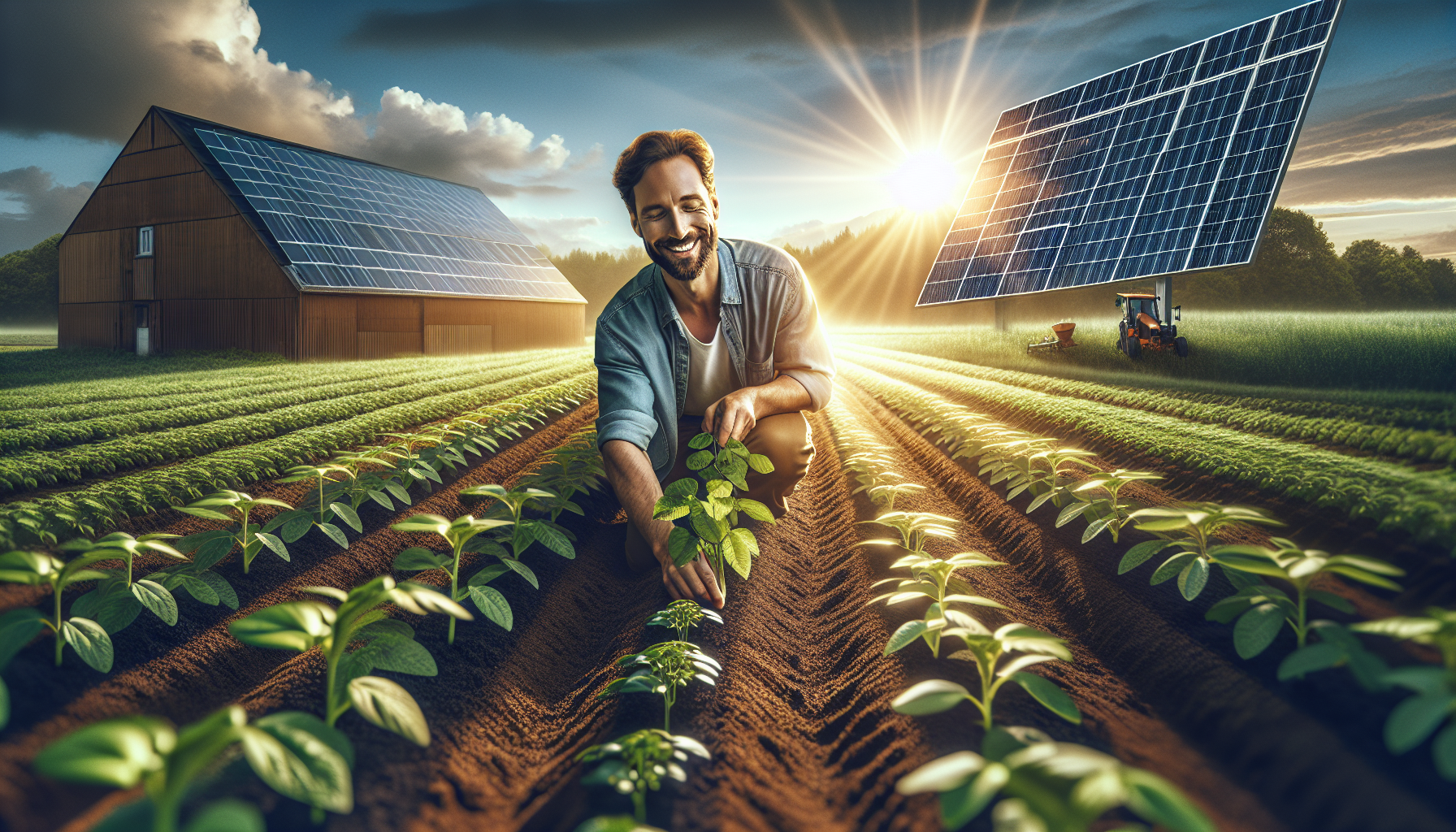In an era where the reverberations of climate change are felt across the globe, our collective responsibility to forge a more sustainable future has never been more pressing. The gentle hum of a revolution is in the air—a transformation that bridges ancient practices with cutting-edge technology. This harmonious blend is found in the burgeoning practice of integrating solar power into planting methods, a forward-thinking approach that not only nurtures our precious environment but also enhances agricultural efficiency. As we stand at the crossroads of innovation and tradition, embracing solar energy in our planting practices offers a tangible pathway toward a greener, more sustainable future. 🌱
Imagine a world where the sun, our most abundant and reliable natural resource, fuels the growth of our food and flora. By harnessing solar power, we tap into an endless supply of clean energy, reducing our reliance on fossil fuels and mitigating the detrimental effects of greenhouse gas emissions. This transformative approach to agriculture offers more than just environmental benefits; it paves the way for economic growth, energy independence, and increased agricultural productivity. In this blog, we will explore the multifaceted benefits of incorporating solar power into planting practices, and how this shift is not only beneficial but essential for sustainable development.
As we delve deeper, we’ll discuss the technological advancements that make this integration possible, from photovoltaic panels to solar-powered irrigation systems. We’ll explore case studies of communities and farmers who have successfully transitioned to solar-powered agriculture, demonstrating the real-world applications and benefits of this approach. Additionally, we’ll examine the economic incentives and policies that support the adoption of solar energy in agriculture, highlighting how individuals and communities can access resources and funding to make this transition a reality.
Furthermore, we will address the challenges and considerations that come with implementing solar power in planting practices, providing insights and strategies to overcome potential obstacles. From initial setup costs to maintenance, we’ll offer a comprehensive guide to help you navigate the journey toward a sustainable agricultural practice. By the end of this article, you’ll be equipped with the knowledge and inspiration needed to sow the seeds of sustainability in your own planting endeavors, contributing to a healthier planet for generations to come. Together, let’s harness the power of the sun to cultivate a brighter, greener future. ☀️
Understanding the Basics of Solar Power in Agriculture
As the world faces increasing environmental challenges, the agricultural sector stands at a crucial juncture. Farmers and agriculturalists worldwide are exploring innovative ways to reduce their carbon footprint and promote sustainable practices. One such method gaining significant traction is the integration of solar power into planting practices. By utilizing solar energy, farms can decrease their reliance on fossil fuels, reduce operational costs, and promote a healthier planet. But what exactly is solar power, and how can it be effectively harnessed in agriculture?
Solar power is the conversion of energy from sunlight into electricity. This is achieved through the use of photovoltaic (PV) panels, which capture sunlight and transform it into usable energy. The adoption of solar technology in agriculture is not just about installing panels on the roofs of barns or sheds. It extends to innovative applications such as solar-powered irrigation systems, greenhouse heating, and even solar tractors. By leveraging this renewable energy source, farmers can achieve a dual benefit: sustainable farming operations and a reduction in greenhouse gas emissions.
The shift towards solar energy in agriculture is not merely a trend but a necessary evolution. With climate change posing a significant threat to food security, the agricultural sector is under pressure to adopt more sustainable practices. Solar energy offers a viable solution, providing a reliable and clean energy source. By sowing the seeds of sustainability through solar power, farmers are not only ensuring the viability of their crops but are also contributing to a greener future for generations to come. 🌱
Benefits of Solar Power in Agriculture
Implementing solar energy in agricultural practices comes with a myriad of benefits that extend beyond environmental considerations. One of the most significant advantages is the reduction in energy costs. Traditional energy sources, like diesel and electricity, can be expensive and subject to price fluctuations. Solar power, once installed, offers a consistent and often more economical energy solution. This financial benefit can be crucial for farmers operating on tight margins, providing an opportunity to reinvest savings into other aspects of their operations.
Moreover, solar power enhances energy security. By reducing dependency on external power sources, farmers gain more control over their energy supply. This is particularly beneficial in remote areas where access to the grid is limited or unreliable. With solar power, farmers can ensure a steady supply of energy, crucial for operations such as irrigation, which is vital for crop health and productivity. The independence from grid power also means that agricultural operations can continue uninterrupted in the event of power outages or fuel shortages.
Another significant benefit of solar power is its positive environmental impact. By transitioning to renewable energy, farmers can significantly reduce their carbon footprint. This is a critical step in mitigating climate change, which poses a direct threat to agriculture through increased instances of droughts, floods, and other extreme weather events. By adopting solar energy, farmers are not only protecting their operations but are also contributing to global efforts to combat climate change. 🌎
Integrating Solar Technology in Planting Practices
The integration of solar technology in planting practices can take various forms, each tailored to meet the specific needs of different agricultural operations. One of the most straightforward applications is the use of solar-powered water pumps for irrigation. These systems use solar panels to power pumps that draw water from underground sources, rivers, or ponds. Solar irrigation systems can be particularly beneficial in regions with abundant sunlight but limited water resources, allowing farmers to efficiently manage their water supply.
In addition to irrigation, solar energy can be utilized in greenhouses, providing a sustainable solution for climate control. Solar panels can be used to generate electricity for heating and cooling systems, ensuring optimal growing conditions for crops. This application is especially valuable for high-value crops that require precise environmental conditions. By leveraging solar power, farmers can reduce their reliance on fossil fuels and decrease their operational costs, making greenhouse farming more sustainable and economically viable.
Another innovative application of solar technology is in powering agricultural machinery. Solar tractors, for example, are becoming an increasingly popular choice among eco-conscious farmers. These tractors use solar panels to generate the electricity needed for their operation, eliminating the need for diesel fuel. This not only reduces emissions but also cuts down on fuel costs, providing a cleaner and more efficient alternative for field operations. 🚜
Overcoming Challenges in Solar Adoption
While the benefits of solar energy in agriculture are clear, there are several challenges that must be addressed to facilitate widespread adoption. One of the primary barriers is the initial cost of solar installation. Although solar technology has become more affordable over the years, the upfront investment can be significant, particularly for small-scale farmers. However, various financial incentives, such as government grants and subsidies, are available to offset these costs, making solar energy more accessible.
Another challenge is the variability of sunlight, which can affect the consistency of energy production. This can be particularly problematic in regions with frequent cloud cover or limited daylight hours. To mitigate this issue, farmers can incorporate battery storage systems that store excess energy generated during peak sunlight hours for use during cloudy days or at night. Additionally, hybrid systems that combine solar with other renewable energy sources, such as wind or biomass, can provide a more reliable energy supply.
Lastly, there is a need for greater awareness and education on the benefits and applications of solar technology in agriculture. Many farmers may be unaware of the available options or lack the technical knowledge to implement solar systems effectively. By providing resources and training, agricultural organizations and governments can empower farmers to make informed decisions and successfully integrate solar energy into their operations. 📚
Case Studies: Success Stories in Solar-Powered Agriculture
To understand the real-world impact of solar energy in agriculture, it is helpful to look at successful case studies from around the world. In India, for example, the use of solar-powered irrigation systems has revolutionized farming in regions with limited water access. These systems have enabled farmers to cultivate crops year-round, increasing food production and improving livelihoods. Similarly, in Africa, solar power is being used to operate cold storage facilities, helping to reduce food spoilage and extend the shelf life of perishable goods.
In the United States, solar energy is being utilized in innovative ways to support sustainable farming practices. One notable example is the use of solar panels to power poultry farms. These systems provide a clean energy source for heating and cooling, ensuring optimal conditions for livestock. By reducing reliance on fossil fuels, poultry farms can decrease their environmental impact while maintaining high standards of animal welfare.
These case studies demonstrate the transformative potential of solar energy in agriculture. By adopting solar technology, farmers can enhance their productivity, reduce costs, and contribute to a more sustainable future. The success stories also highlight the importance of tailoring solar solutions to meet the specific needs of different agricultural operations, ensuring maximum efficiency and effectiveness. 🌍
| Application | Benefits | Challenges |
|---|---|---|
| Solar Irrigation | Cost savings, water efficiency, energy independence | High initial cost, variable sunlight |
| Greenhouse Heating/Cooling | Climate control, reduced fossil fuel use | Installation complexity, energy storage needs |
| Solar-Powered Machinery | Reduced emissions, fuel cost savings | Limited availability, high initial cost |
Exploring Further Resources
For those interested in exploring solar energy in agriculture further, numerous resources are available to provide guidance and support. Online platforms and agricultural organizations offer valuable insights into best practices, technological advancements, and financial incentives. Farmers can benefit from workshops and training programs that provide hands-on experience and technical knowledge essential for successful solar integration.
Additionally, online videos and tutorials can be an excellent way to visualize the application of solar technology in agriculture. One such resource is the YouTube video titled “Harnessing the Sun: Solar Power in Agriculture” by the channel Sustainable Farming. This video provides a comprehensive overview of how solar energy can be integrated into various agricultural practices, offering practical tips and real-world examples. Watch the video here to learn more. 🎥
- Explore government incentives for solar adoption in agriculture.
- Attend workshops and training programs on solar technology.
- Collaborate with solar energy experts for tailored solutions.
By leveraging these resources, farmers can gain the knowledge and support needed to successfully implement solar energy into their operations. This not only enhances the sustainability of their practices but also contributes to a greener and more prosperous future for the agricultural sector. 🍀

Conclusion
Conclusion: Sowing the Seeds of a Sustainable Future
In the journey of exploring the integration of solar power into planting practices, we have traversed a landscape rich with opportunities and innovations. The potential of solar energy to revolutionize agricultural practices is both promising and necessary in our collective pursuit of a greener future. Throughout this article, we’ve delved into the transformative effects of harnessing solar power, examined the technical and economic aspects, and highlighted real-world applications that underscore the viability of this approach.
To recapitulate, we began by discussing the urgency of addressing climate change and the role agriculture plays both as a contributor to and a victim of environmental shifts. The traditional methods, though effective in the past, now need to evolve to meet the demands of sustainability. Solar power emerges as a viable solution, offering a renewable, cost-effective, and environmentally friendly alternative to fossil fuels. By reducing reliance on non-renewable energy sources, we can significantly lower carbon emissions and mitigate the impacts of global warming. 🌍
The article highlighted various ways solar energy can be integrated into planting practices. We explored solar-powered irrigation systems that ensure efficient water use, thereby addressing water scarcity issues prevalent in many agricultural regions. These systems not only conserve water but also reduce electricity costs, ultimately enhancing the economic resilience of farming operations. Solar greenhouses, another innovative application, utilize photovoltaic panels to maintain optimal growing conditions, extending growing seasons and increasing yield potential.
Economic viability is a crucial factor in the adoption of any new technology. We examined the financial benefits of solar installations, including government incentives, reduced operational costs, and increased property values. The initial investment, while significant, is often offset by these long-term savings and benefits. Furthermore, the scalability of solar technology makes it accessible to a range of agricultural operations, from small family farms to large commercial enterprises.
Real-world examples provided tangible evidence of solar power’s impact on agriculture. We looked at case studies where farmers have successfully integrated solar technologies, resulting in increased productivity and sustainability. These success stories serve as powerful testimonies to the potential of solar energy to transform agricultural practices globally. 🌱
As we conclude, it is imperative to reinforce the importance of this topic. The integration of solar power into agriculture is not merely a trend; it is a necessary evolution in our pursuit of environmental sustainability and food security. The stakes are high, and the need for action is immediate. By adopting solar energy, farmers and agricultural stakeholders can play a pivotal role in mitigating climate change and fostering a healthier planet for future generations.
The information presented here serves as a call to action for all readers. Whether you are a farmer, a policymaker, or simply someone interested in sustainable practices, your engagement is crucial. Share this knowledge, discuss it with peers, and consider how you can apply these principles in your context. By working together, we can sow the seeds of sustainability and cultivate a future that is both prosperous and environmentally sound.
We encourage you to leave your thoughts and experiences in the comments below. Your insights could inspire others and foster a collaborative community dedicated to green innovation. Additionally, sharing this article within your networks can amplify the message and accelerate the transition to sustainable agricultural practices.
As we stand at the crossroads of innovation and tradition, let us choose the path of sustainability. By harnessing the power of the sun, we can illuminate a future where agriculture thrives in harmony with the natural world. Let us plant the seeds of change today, for a greener, more sustainable tomorrow. 🌞
For further reading and research, here are some active resources:
–
–
– Case Studies in Solar-Powered Agriculture
These resources provide additional insights and case studies that complement the discussion in this article, offering a deeper understanding of the impact and potential of solar power in agriculture.
Toni Santos is a visual storyteller and symbolic naturalist whose creations explore the hidden ecologies and forgotten bonds between humans and nature, as whispered through ancient lore. Through an intuitive and myth-sensitive lens, Toni reveals the sacred choreography between flora, fauna, and human spirit — a world where trees once spoke, rivers remembered, and every herb carried a secret name.
His journey is rooted in the esoteric — in the rituals of forest-dwellers, the botanical codes of shamans, and the unspoken pacts that shaped how ancient peoples lived in deep, reciprocal harmony with the natural world. From sacred groves to serpent-guarded springs, each of Toni’s works reflects a symbolic relationship long obscured by modern forgetfulness.
With a background in visual design and ancestral aesthetics, Toni merges storytelling with sacred ecology. His pieces don’t simply illustrate — they channel. Drawing from myth, mysticism, and lost herbal traditions, he crafts visuals that resonate with the old wisdom: that nature is not background, but kin.
As the creative spirit behind Vizovex, Toni shares collections, visual studies, and articles that illuminate the occulted connections between human life and the wild world. His work calls on us to remember — not just with the mind, but with the senses and the soul — the profound dialogues our ancestors once had with earth, plant, and animal.
His work is a tribute to:
The mythic language of trees, stones, and roots
Forgotten pacts between healers and the wilderness
The sacred knowledge carried in nature’s unseen patterns
Whether you’re a seeker of ancient plant-lore, a mystic attuned to seasonal cycles, or simply someone who hears the forest speak, Toni welcomes you to wander a space where symbolism, nature, and spirit entwine — one myth, one leaf, one vision at a time.





